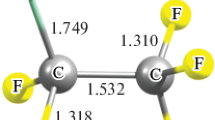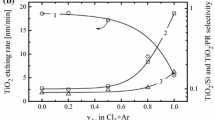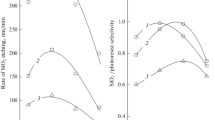Abstract
In this study, the dependence of the plasma-chemical-etching rate and the surface roughness of a gallium-arsenide crater on the concentration of chloropentafluoroethane (C2F5Cl) in a mixture with chlorine, the capacitive discharge power, and the etching duration are investigated. The characteristics of the GaAs etching crater are studied by white-light interferometry and scanning electron microscopy. It is shown that the addition of C2F5Cl into the chlorine-containing inductively coupled plasma leads to a nonlinear change in the gallium-arsenide etching rate with time, which can be explained by passivation of the substrate surface at the initial stage by the products of freon decay. Along with this, characteristics of the etching profile of GaAs are substantially improved. An increase in the capacitive discharge power promotes the development of roughness, while the etching rate increases nonlinearly.
Similar content being viewed by others
Explore related subjects
Discover the latest articles, news and stories from top researchers in related subjects.Avoid common mistakes on your manuscript.
1 INTRODUCTION
The formation of nonplanar structures based on gallium arsenide with vertical walls is a rather difficult problem. One of the most widely used methods for this is etching in inductively coupled plasma (ICP) [1–6]. Due to an increased concentration of reaction particles in the plasma, it is possible to maintain a significant etching rate without a substantial increase in the capacitive power (radio frequency power, RFp). However, it is necessary to protect the lateral surface of the sample from horizontal etching in this case, since the ICP etching is isotropic in nature. In this regard, polymer-forming reagents, such as BCl3 [1, 2], SiCl4 [3, 4], and CHF3 [5], are often used. In particular, the anisotropic plasma-chemical etching of holes in a GaAs plate with a diameter of 50 μm in an inductively coupled Cl2/BCl3 plasma to a depth of >150 μm was carried out in [1] under a photoresist mask. The effects of the pressure and the percentage of BCl3 on the process rate and the smoothness of the etching profile were studied at constant capacitive and inductive powers of the inductively coupled plasma (ICPp) and a fixed total flow. It was found that the pressure has a significant effect on the energy of heavy ions. The energies of various types of ions in the plasma varied in the range from 1.85 to 7.5 eV with the pressure range from 20 to 50 mTorr. The etching rate decreased with an increase in the percentage of BCl3. With 42% BCl3 and a pressure of 30 mTorr, vertical depressions with a smooth bottom were obtained in GaAs. In [2], the etching parameters of semiconductor GaAs/AlGaAs heterostructures in a BCl3/Cl2/Ar/N2 plasma were optimized. A small addition of nitrogen was found to be effective in protecting the sidewalls from undercutting when using a photoresist mask. Deep grooves with a high aspect ratio and vertical side walls with a maximum depth of 121 μm were formed in GaAs wafers by the inductively coupled plasma/reactive-ion etching (ICP/RIE) method in a Cl2/Ar plasma [3]. The effects of the capacitive power (from 80 to 200 W), plasma-gas composition, and pressure (0.1–2.5 Pa) on the selectivity and shape of the profile of gallium-arsenide etching under a SiO2 mask with a thickness of 10 μm were studied. In high-pressure modes, a selectivity of more than 50 : 1 was achieved for GaAs etching with respect to SiO2. It was also found that the etching quality of the GaAs side walls can be improved by adding SiCl4 to the gas mixture.
In [4], a reproducible process of the reactive ion etching of GaAs in an inductively coupled SiCl4/Cl2/Ar plasma was developed. Passivation of the reactor chamber by preliminary conditioning resulted in a more stable process at a well controlled rate. The etched surface and side-wall profiles obtained by this method were smooth, and the spread of the etching depth did not exceed 2% of the 1.25 μm value. In [5], a method was developed for fabricating well-ordered periodic GaAs nanowires (NWs) on the basis of a combination of colloidal lithography and inductively coupled plasma-etching technology with a mixture of CHF3/Ar and Cl2/N2/BCl3 gases. The effects of the flow of reagents and the duration of etching on the features of the formation of the NWs were studied. The reflection spectra of the NWs are measured and compared with the spectra of samples obtained by molecular-beam epitaxy. In our previous study [6], the deep etching of gallium arsenide (7 μm) in an inductively coupled plasma of chloropentafluoroethane (C2F5Cl) was shown despite passivation of the reagent by the decomposition products. The morphology of the etched surface and the chemical composition of the passivating coatings were investigated. It was shown that the smoothest and most polishing etching is achieved when using the mode with a low capacitive power and a high freon flow. In this study, we investigate the effect of the addition of C2F5Cl into the composition of a chlorine-containing plasma on the rate and profile characteristics of gallium-arsenide etching.
2 EXPERIMENTAL
Before etching, the surface of gallium arsenide was cleaned from the oxide layer by liquid treatment in hydrochloric acid. Plasma-chemical etching was performed on an Oxford PlasmaLab 80 setup with an inductively coupled plasma source with a frequency of 13.56 MHz. A pulsed mode that combines stages of etching with a duration of 30 s and inactivity of the system (with the plasma generator turned off) was used. The power of the inductive discharge remained constant throughout the experiment (290 W). The total flow of reagents (Cl2 + C2F5Cl) was 60 cm3/min, and the pressure was 11 mTorr. The ratio of the mass flow rate of C2F5Cl to the total gas flow (x), the RFp, and the etching time (t) were varied. To prevent overheating, the sample was placed on a sapphire substrate (located on the lower Al electrode) to which gaseous helium was supplied from below. Thermal contact was ensured by vacuum lubrication; at the end of the process, the lubricant was removed by washing in hexane. The surface topology was formed using the photolithographic method on an SUSS MJB4 device. As the masks, we used layers of a photoresist and nickel with thicknesses of 1.4 μm and 150 nm, respectively. A metallic mask was applied to the sample by electron-beam deposition (Amod 206). The etching rate (r) and the profile characteristics of gallium arsenide were studied by white-light interferometry (Talysurf CCI 2000) and scanning electron microscopy (ZEISS EVO 10).
3 RESULTS AND DISCUSSION
As was found in the study, the addition of an insignificant amount of chloropentafluoroethane to chlorine-containing plasma (at RFp = 75 W) at a short process time (t = 1.5–2.5 min) greatly reduces the etching rate of gallium arsenide. Thus, the use of 8.3% C2F5Cl promotes a decrease in r by a factor of more than 20 (up to 200 nm/min) compared to the use of pure chlorine. An increase in the chloropentafluoroethane content to 33% leads to a decrease in the etching rate by a factor of 2.5. The passivation process begins to dominate with a further increase in the freon concentration, as a result of which nonvolatile GaF3 blocking the access of reaction particles to the GaAs surface is formed by the following reaction:
This is confirmed by the fact that successive variation in the x parameter from 33 to 83% had no effect on the etching rate, which remained at a level of 80 nm/min. It should also be noted that the smooth surface of gallium arsenide was obtained after etching in plasma with x ≥ 33%. In contrast, the surface roughness (Sq) became more significant with x = 8.3% and a highly developed surface was formed when pure chlorine was used.
The effect of the capacitive discharge power on the etching rate of GaAs (at x = 8.3%) was studied. An increase in RFp from 10 to 75 W led to a sixteen-fold increase in the process rate, while r increased only by a factor of 1.5 (up to 300 nm/min) in the range from 75 to 150 W. Another noticeable effect associated with RFp is manifested in deterioration of the surface characteristics of GaAs (at RFp = 150 W, Sq reached tens of nm). In comparison, etching at 10 W was characterized by the formation of a uniform smooth surface with Sq = 0.5 nm (Fig. 1).
Interestingly, a sharp increase in the etching rate was observed with a longer process time (t = 15 min). Thus, r increased by a factor of 2 for x = 8.3%, 8 for x = 33%, and more than 9 for x = 66% (up to 740 nm/min). Heating of the substrate can be excluded, since etching was carried out at room temperature (because of heat removal by gaseous helium). In our opinion, the charging of the GaAs surface, which leads to enhanced ion bombardment and removal of the passivating film of gallium fluoride formed at the initial stage of etching, is among the possible reasons explaining such a sharp increase in the rate of the process with time.
It should be noted that, it was possible to obtain a uniform smooth etching profile with vertical walls to a depth of 11 µm in the case with x = 66% (Fig. 2a). In comparison, the etching profile of GaAs in a Cl2 plasma without freon was characterized by the presence of large inhomogeneities at the bottom, the size of which was about a hundred nm (Fig. 2b). The aspect ratio achieved by the etching of gallium arsenide with the addition of C2F5Cl was more than 35:1 (Fig. 3).
4 CONCLUSIONS
The results of the performed studies show that the addition of chloropentafluoroethane into the composition of chlorine-containing inductively coupled plasma helps to reduce the etching rate of gallium arsenide by a few times along with an improvement in the surface characteristics of the resulting crater. Thus, a uniform vertical profile of GaAs etching with an aspect ratio of no worse than 35:1 is obtained with a C2F5Cl content of 66% in a mixture with Cl2. In contrast, etching in chlorine without the addition of freon with similar operating parameters leads to the formation of a highly rough surface.
REFERENCES
D. S. Rawal, B. K. Sehgal, R. Muralidharan, and H. K. Malik, Plasma Sci. Technol. 13, 223 (2011).
P. B. Vigneron, F. Jointa, N. Isac, R. Colombelli, and E. Herth, Microelectron. Eng. 202, 42 (2018).
K. Booker, Y. Osorio Mayon, C. Jones, M. Stocks, and A. Blakers, J. Vac. Sci. Technol. B 38, 012206 (2020).
M. K. Connors, J. J. Plant, K. G. Ray, and G. W. Turner, J. Vac. Sci. Technol. B 31, 021207 (2013).
K. Chen, Jian-Jun He, Ming-Yu Li, and R. LaPierre, Chin. Phys. Lett. 29, 036105 (2012).
A. I. Okhapkin, P. A. Yunin, M. N. Drozdov, S. A. Kraev, E. V. Skorokhodov, and V. I. Shashkin, Semiconductors 52, 1473 (2018).
Funding
This study was supported by stipend SP-2056.2021.3 of the President of the Russian Federation for young scientists and graduate students. Plasma-chemical etching and analysis of the obtained surface profile of gallium arsenide were carried out using equipment of the Center for Collective Use “Physics and Technology of Micro- and Nanostructures,” Institute for Physics of Microstructures, Russian Academy of Sciences.
Author information
Authors and Affiliations
Corresponding author
Ethics declarations
The authors declare that they have no conflicts of interest.
Additional information
Translated by O. Kadkin
Edited by L.V. Sharonova
Rights and permissions
About this article
Cite this article
Okhapkin, A.I., Kraev, S.A., Arkhipova, E.A. et al. Effect of the Chloropentafluoroethane Additive in Chlorine-Containing Plasma on the Etching Rate and Etching-Profile Characteristics of Gallium Arsenide. Semiconductors 55, 865–868 (2021). https://doi.org/10.1134/S1063782621100171
Received:
Revised:
Accepted:
Published:
Issue Date:
DOI: https://doi.org/10.1134/S1063782621100171







